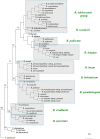Diversity, ecology and intestinal function of bifidobacteria
- PMID: 25186128
- PMCID: PMC4155821
- DOI: 10.1186/1475-2859-13-S1-S4
Diversity, ecology and intestinal function of bifidobacteria
Abstract
The human gastrointestinal tract represents an environment which is a densely populated home for a microbiota that has evolved to positively contribute to host health. At birth the essentially sterile gastrointestinal tract (GIT) is rapidly colonized by microorganisms that originate from the mother and the surrounding environment. Within a short timeframe a microbiota establishes within the (breastfed) infant's GIT where bifidobacteria are among the dominant members, although their numerical dominance disappears following weaning. The numerous health benefits associated with bifidobacteria, and the consequent commercial relevance resulting from their incorporation into functional foods, has led to intensified research aimed at the molecular understanding of claimed probiotic attributes of this genus. In this review we provide the current status on the diversity and ecology of bifidobacteria. In addition, we will discuss the molecular mechanisms that allow this intriguing group of bacteria to colonize and persist in the GIT, so as to facilitate interaction with its host.
Figures


References
-
- Turroni F, Peano C, Pass DA, Foroni E, Severgnini M, Claesson MJ, Kerr C, Hourihane J, Murray D, Fuligni F, Gueimonde M, Margolles A, De Bellis G, O'Toole PW, van Sinderen D, Marchesi JR, Ventura M. Diversity of Bifidobacteria within the Infant Gut Microbiota. PLoS One. 2012;7:e36957. doi: 10.1371/journal.pone.0036957. - DOI - PMC - PubMed
Publication types
MeSH terms
Substances
LinkOut - more resources
Full Text Sources
Other Literature Sources
Molecular Biology Databases

